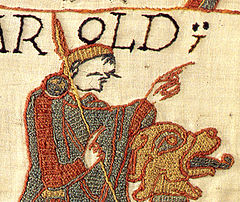| Harold Godwinson | |
|---|---|
 Harold Godwinson, from the Bayeux Tapestry | |
| King of the English | |
| Reign | 5 January – 14 October 1066 |
| Coronation | 6 January 1066 |
| Predecessor | Edward the Confessor |
| Successor |
|
| Born | c. 1022 Wessex, England |
| Died | 14 October 1066 (aged about 44) near Senlac Hill, Sussex, England |
| Burial | Waltham Abbey, Essex, or Bosham, Sussex (disputed) |
| Spouses | |
| Issue | |
| House | Godwin |
| Father | Godwin, Earl of Wessex |
| Mother | Gytha Thorkelsdóttir |
Harold Godwinson (c. 1022 – 14 October 1066), also called Harold II, was the last crowned Anglo-Saxon English king. Harold reigned from 6 January 1066[1] until his death at the Battle of Hastings on 14 October 1066, the decisive battle of the Norman Conquest. Harold's death marked the end of Anglo-Saxon rule over England. He was succeeded by William the Conqueror.
Harold Godwinson was a member of a prominent Anglo-Saxon family with ties to Cnut the Great. He became a powerful earl after the death of his father, Godwin, Earl of Wessex. After his brother-in-law, King Edward the Confessor, died without an heir on 5 January 1066, the Witenagemot convened and chose Harold to succeed him; he was probably the first English monarch to be crowned in Westminster Abbey. In late September, he successfully repelled an invasion by rival claimant Harald Hardrada of Norway in York before marching his army back south to meet William at Hastings two weeks later.
- ^ DeVries 1999, p. 230.